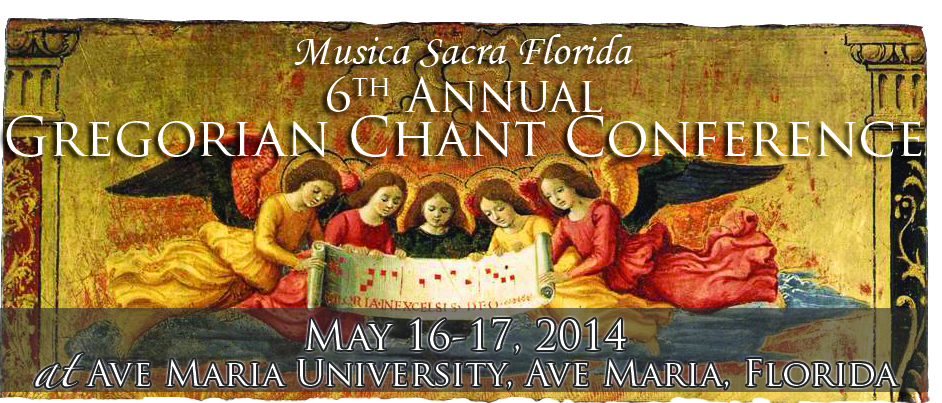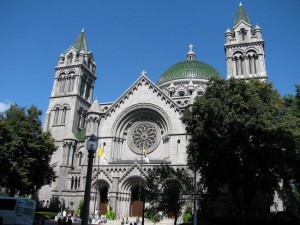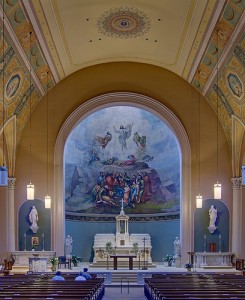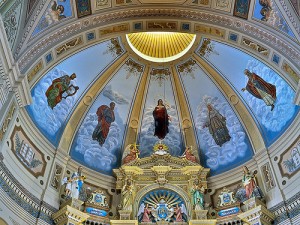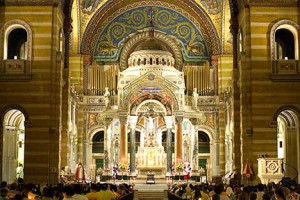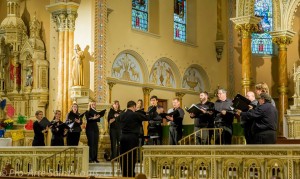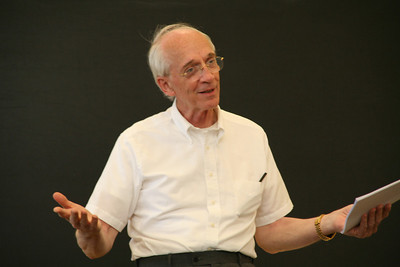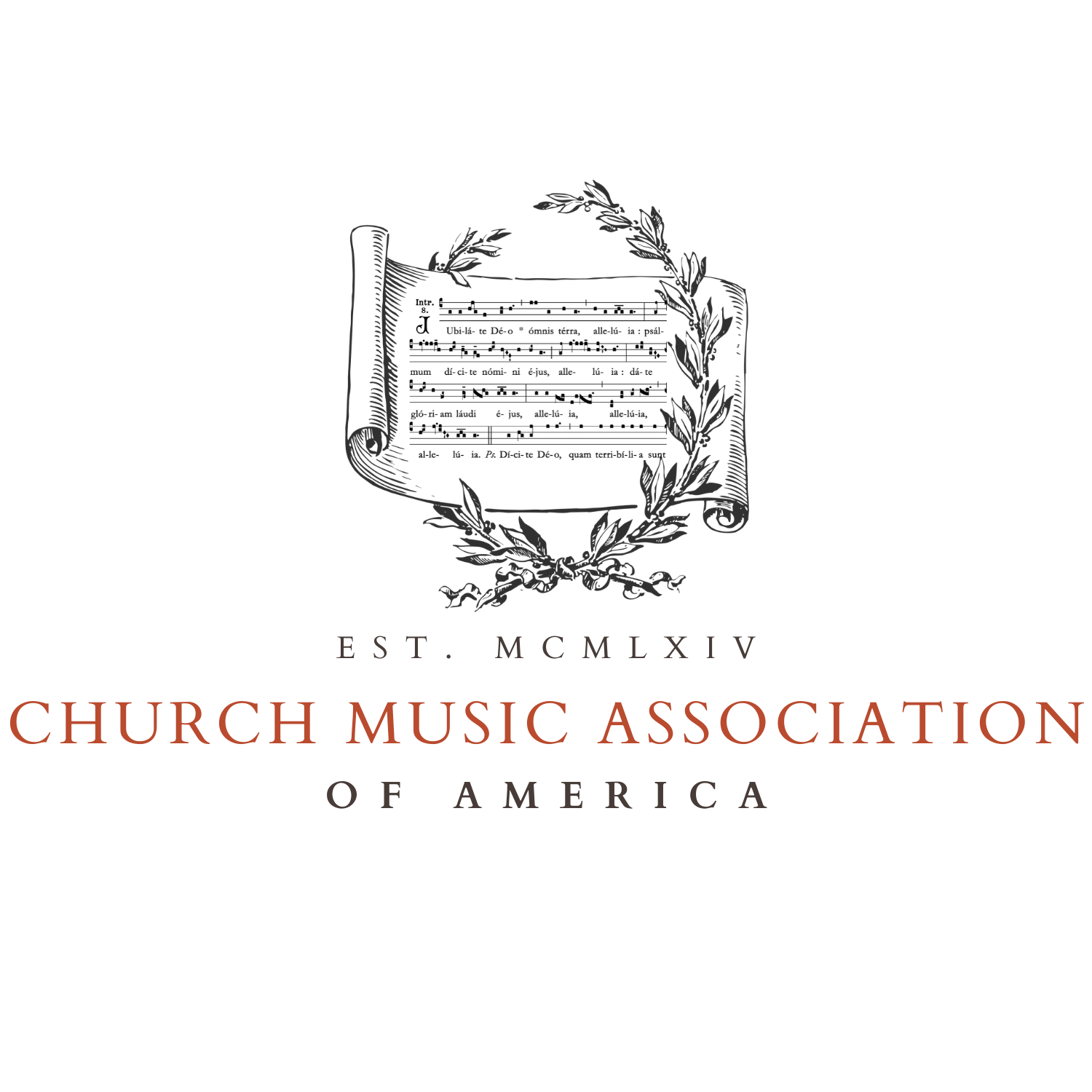6th Annual Gregorian Chant Conference and Extraordinary Form Server Training Workshop
Chant Conference: Friday, May 16 & Saturday, May 17, 2014
Server Training Workshop: Thursday, May 15 & Friday May 16, 2014
at Ave Maria University, Ave Maria, FL 34142
The Florida Chapter of the Church Music Association of America & the Department of Music at Ave Maria University are pleased to announce the sixth annual conference in Gregorian Chant.
The Conference will include:
NEW: Special workshop on Thursday & Friday for altar servers at the Extraordinary Form. This year’s workshop will focus on serving a pontifical High Mass. The workshop will be taught by Fr. Scott Haynes of the Society of St. John Cantius. Participants in the server training workshop are welcome to stay for the Saturday portion of the chant conference. Participants under the age of 18 accompanied by a chaperone are also welcome (contact Susan Treacy for more details).
Workshops in
Choice of scholae for beginning/intermediate (men & women), upper-level men, & upper-level women
Missa cantata in the Extraordinary Form on Friday evening with chants provided by the Schola Cantorum of Saints Francis & Clare (Miami)
Closing Missa cantata in the Ordinary Form on Saturday evening with English & Latin chants provided by conference participants
Register online at: www.musicasacra.com/florida
Registration fees: $60.00 (including materials & instruction), $15.00 for fulltime students with I.D., priests, religious, and seminarians
Registration deadline: Friday, May 2nd, 2014 Deadline extended to Monday, May 12th.
For more information on the conference,
contact Susan Treacy, Ph.D., at: susan.treacy@avemaria.edu | (239) 280-1668
www.musicasacra.com/florida
Conference Faculty:
Keynote Speaker: Father Scott Haynes, SJC, of Saint John Cantius Church, Chicago
Mary Jane Ballou, D.S.M. – Cantorae Saint Augustine
Adam Bartlett – Liturgical Institute, Mundelein, IL
Jennifer Donelson, D.M.A. – Nova Southeastern University
Jeffrey Herbert, CAGO/ChM – Music Director, Saint Raphael Church, Englewood, FL
Susan Treacy, Ph.D. – Ave Maria University
Sponsored by the Florida Chapter of the Church Music Association of America (CMAA)
in conjunction with
Ave Maria University, Ave Maria, FL 34142
About the Conference:
This two-day workshop will present beginning, intermediate, and advanced musicians with rehearsals and lectures that will enrich their knowledge of Gregorian chant and its use in the Roman Catholic liturgy.
Led by a faculty of chant specialists from around the state, attendees will learn practical methods for teaching chant and introducing it into the parish, as well as experience the chant in the context of both the Divine Office and the Mass. Beginning chanters will be introduced to the basics of notation and rhythm according to the classic Solesmes method.
Experienced chanters will learn new repertoire and advance their understanding of rhythmic and interpretive nuance. Resources and practical methods for the cultivation of Gregorian chant in the life of the parish will also be discussed, especially in light of the new missal. This year there will again be a special emphasis on Gregorian chant in English & attendees will be introduced to an exciting new parish music program, the Lumen Christi series.
This workshop is ideal for choir members, parish music directors, Gregorian schola directors, music students, teachers, parents, seminarians, priests, deacons, and anyone who is interested in learning about the heritage of sacred music within the Roman Catholic Church.
Registration:
Registration fees are $60 ($15 for fulltime students with ID, priests, religious, and seminarians) and include the price of instructional materials and instruction. Payment is made online.
Board Options:
|
Friday Catered Dinner (Remit along with Registration.) |
Estimated $30 |
Other meals “on your own”:
For Saturday’s breakfast and lunch, conference attendees may eat at the AMU cafeteria or at restaurants in La Piazza, surrounding The Oratory of Ave Maria.
For those who would like, a group will be going to a restaurant in Naples for Saturday evening dinner.
Room Options:
Overnight accommodations will be available at AMU’s Xavier Hall.
Participants may choose between the following room options for lodging.
|
Xavier Conference Center – Single occupancy |
$50 |
|
Xavier Hall – Double occupancy |
($35 per person) $70 |
Please reserve Xavier Hall accommodations separate from your conference registration by downloading the PDF form at the following link:
MSF 2014-Xavier Room Reservation Form
Pre-registration is required.
Deadline: Friday, May 2nd, 2014
Conference Faculty:
Mary Jane Ballou – Cantorae St. Augustine, St. Augustine, FL
Mary Jane Ballou performs professionally on the Celtic harp and a wire-strung salterio built by the Benedictine monks of the Abbaye of En Calcat in France. Currently based in St. Augustine, Florida, Dr. Ballou performs throughout the Southeast. Her recordings are available online at CD Baby. Dr.Ballou also produces and hosts Classical Fan Club, a weekly radio show featuring music “off the beaten track” on Flagler College Radio, WFCF St. Augustine 88.5. She is also the founder & director of Cantorae St. Augustine, a women’s ensemble dedicated to Gregorian chant & polyphony.
Adam Bartlett – The Liturgical Institute, Mundelein Seminary, Mundelein, IL
Adam Bartlett is an internationally recognized composer, editor, conductor and teacher of Catholic sacred music. He serves as editor of Illuminare Publications and as an adjunct faculty member at The Liturgical Institute of the University of St. Mary of the Lake, and Mundelein Seminary. He received his B.A. degree in Music from Arizona State University, studied Gregorian chant as an apprentice to Dom Columba Kelly, OSB, of St. Meinrad Archabbey, and is currently completing his M.A. degree in Liturgical Studies from the Liturgical Institute of the University of St. Mary of the Lake.
He is the composer and editor of Simple English Propers (CMAA, 2011), is the editor of the Lumen Christi Missal and Lumen Christi Simple Gradual (Illuminare Publications, 2012 and 2014, respectively), and is currently completing the Lumen Christi Series—a complete parish sacred music program—which additionally will include a hymnal, full English gradual, and various accompaniment editions. Active as a teacher, workshop leader and speaker, Adam has travelled throughout the country to offer catechetical and training workshops on topics of Catholic sacred music and liturgical chant. He teaches Liturgical Chant I, II and III at Mundelein Seminary—the first required sacred music courses at this institution since 1968—and is responsible for the development of the curriculum for these courses. Active as a parish music director for over ten years, he most recently served as Director of Sacred Music at SS. Simon and Jude Cathedral in Phoenix, AZ. He has contributed to the journal Sacred Music, and has written articles for the Chant Cafe, New Liturgical Movement, and various other liturgical publications.
Jennifer Donelson – Nova Southeastern University, Fort Lauderdale, FL
Jennifer Donelson is an assistant professor of music at Nova Southeastern University in Ft. Lauderdale where she teaches piano, musicology, & music theory, as well as directs the choirs. She received her D.M.A. in Piano Performance from the University of Nebraska-Lincoln. A specialist in the piano works and writings of Olivier Messiaen, she has lectured on and given performances throughout the USA, France, & Mexico. She serves as the Academic Liaison of the Church Music Association of America and the associate managing editor of the CMAA’s journal, Sacred Music. She is the co-editor of a forthcoming volume of essays on Charles Tournemire (CMAA, Summer 2014). Having studied chant at Catholic University of America and the Abbey of St. Peter in Solesmes, Dr. Donelson has served as music director at St. Gregory the Great Seminary (Diocese of Lincoln, NE) and St. Thomas Aquinas Newman Center (UNL) where she founded the Cor Immaculatae Schola Cantorum, a semi-professional ensemble dedicated to the performance of Gregorian chant and sacred polyphony. She has given workshops in Gregorian chant for the Archdiocese of Miami & the Diocese of Peoria, is a co-founder of the Musica Sacra Florida Gregorian chant conference, & has served on the faculty of the annual colloquium of the CMAA. Currently Dr. Donelson directs the schola cantorum of Sts. Francis and Claire parish in Miami.
Father Scott A. Haynes, SJC – Saint John Cantius Church, Chicago, IL
Completing studies in philosophy at Our Lady of Guadalupe Seminary in Denton, NE, & theological studies at Holy Apostles Seminary, in Cromwell, CT, Fr. Haynes received the M.Div. degree in 2006. Ordained to the priesthood in 2007 by Francis Cardinal George, OMI, for the Archdiocese of Chicago as a member of the Canons Regular of St. John Cantius, Fr. Haynes serves as Associate Pastor of St. John Cantius Church. As organ and choral scholar at Washington National Cathedral from 1994-98, Haynes studied under Dr. Douglas Major, Organist & Choirmaster. He completed choral conducting studies at the University of Alabama under Dr. Sandra Willets, complemented by postgraduate studies at Westminster Choir College, Princeton, NJ. Having studied composition under Dr. Frederic Goosen, Haynes won the American Society of Composers and Arrangers’ Raymond Hubbell Award for orchestral composition in 1992. Today, he composes liturgical music for the choirs of St. John Cantius.
Jeffrey A. Herbert – Saint Raphael Catholic Church, Englewood, FL
Jeffrey Herbert, CAGO/ChM, is Director of Music at Saint Raphael Catholic Church in Englewood, Florida, and also serves on the Music Committee for the Diocese of Venice in Florida. After receiving a B.Mus. in Organ/Composition from Shenandoah Conservatory, Winchester, VA, and an M.Mus. in Organ/Composition from the University of Illinois, he has served in full-time parish ministry since 1991. An advocate for the re-introduction of traditional sacred music to parish liturgies, Mr. Herbert presented workshops for the Diocese of Venice on Chant and the New Translation of the Roman Missal as part of the diocesan preparation for the implementation of the new translation, introducing parish music directors and cantors to the use of vernacular chant in their parish music programs. He also sings with the schola at Christ the King Church in Sarasota (FSSP).
Susan Treacy – Ave Maria University, Ave Maria, FL
Susan Treacy, Ph.D., joined the faculty at AMU after having taught at Franciscan University of Steubenville. She has also been a visiting professor at The Liturgical Institute, University of Saint Mary of the Lake, Mundelein, IL. Dr. Treacy holds a Ph.D. in historical musicology from the University of North Texas, a M.Mus. from the Manhattan School of Music, and a B.Mus. from Oberlin College Conservatory. Her research interests are in Catholic liturgical music and English devotional song, and besides having published scholarly articles, Dr Treacy writes a regular column, “Musica Donum Dei,” for the Saint Austin Review and is a contributor to Sacred Music. Dr Treacy directs the Women’s & Men’s Scholæ at AMU, and while at Franciscan University she directed the Schola Cantorum Franciscana. She was a member of the editorial committee for the first edition of The Adoremus Hymnal and is on the Board of Directors of the Church Music Association of America.
Location:
Ave Maria University, 5050 Ave Maria Boulevard, Ave Maria, FL 34142
A campus map can be accessed at:
http://www.avemaria.edu/Portals/0/Images/Kevins’%20Images/New%20Campus%20Map%20(04-16-12).pdf
All events except the Masses are located in the Henkels Academic Building and the Bob Thomas Student Union, labeled 3 and 4 on the campus map.
Directions: http://www.avemaria.edu/AdmissionsAid/VisitOurCampus/MapsDirections.aspx
From Miami-Ft. Lauderdale
From I-75 take Exit 80 towards the North, and proceed 10 miles. At Oil Well Road, make a left turn (towards the West) at the CITGO station and proceed 5 miles. The entrance to Ave Maria (Ave Maria Blvd) is on the right. The University’s Visitor Center is conveniently located in LaPiazza, approximately 3 miles north of the entrance.
If you coming from the West Coast of Florida
Take I-75to Exit 111 (Immokalee Road) and proceed east 10 miles to Oil Well Road. Turn right and proceed 10 miles. The entrance to Ave Maria (Ave Maria Blvd) is on the left. The University’s Visitor Center is conveniently located in LaPiazza, approximately 3 miles north of the entrance.
From Southwest Florida International Airport (RSW)
Exit the airport and follow the signs to I-75. Proceed south to Exit 111 (Immokalee Road) and proceed east 10 miles to Oil Well Road. The entrance to Ave Maria (Ave Maria Blvd) is on the left. The University’s Visitor Center is conveniently located in La Piazza, approximately 3 miles north of the entrance. Turn right and proceed 10 miles. Ave Maria is on the left.
From Naples Municipal Airport, take Airport Road north 8.3 miles to Immokalee Road, then turn east and travel 11.6 miles to Oil Well Road. Turn right and proceed 10 miles. Ave Maria is on the left.
Parking:
Free parking is available on campus and in the town of Ave Maria. See the campus map for parking lot locations. http://www.avemaria.edu/Portals/0/Uploads/352.pdf
Musica Sacra Florida
Gregorian Chant Conference 2014 @ Preliminary Schedule
|
Time |
Event |
Venue |
||||
|
|
|
|
||||
|
Thursday, May 15th |
Altar Server Workshop |
Student Union Building |
||||
|
10:00am-6:00pm |
Altar Server Workshop (includes break for lunch) |
SUB Chapel |
||||
|
Friday, May 16th 9:00am-3:00pm |
Altar Server Workshop (includes break for lunch) |
SUB Chapel |
||||
|
|
|
|
||||
|
Friday, May 16th |
|
Henkels Academic Building |
||||
|
2:30-4:00 |
Registration & Snacks |
Outside Demetree Auditorium |
||||
|
4:00 |
Welcome |
Demetree Auditorium |
||||
|
4:15-5:15 |
Keynote Lecture (Haynes): “The Beauty &Spirituality of Sacred Music” |
Demetree Auditorium |
||||
|
5:15-5:30 |
Break |
|
||||
|
5:30-6:30 |
Conference Tracks 1 |
Henkels Academic Building |
||||
|
|
a. For Chant Directors & Aspiring Chant Directors: How to Learn & Teach a New Chant (Ballou) |
Demetree Auditorium |
||||
|
|
b. Gregorian Chironomy (Donelson) |
Classroom 1011 |
||||
|
|
c. Basic Gregorian Chant Notation (Treacy)
|
Classroom 1012 |
||||
|
|
d. Chant in English & A New Parish Music Program: The Lumen Christi Series (Herbert)
|
Classroom 1014 |
||||
|
6:30 |
Break and Preparation for Mass |
|
||||
|
7:00 |
Missa Cantata in the Extraordinary Form |
The Oratory |
||||
|
8:30 |
Festive Catered Dinner |
The Bean/Queen Mary Pub |
||||
|
|
|
|
||||
|
Saturday, May 17th |
|
Student Union Building (SUB) |
||||
|
7:30-7:50 |
Lauds |
SUB Chapel |
||||
|
7:50-8:30 |
Late Registration / Breakfast |
AMU Cafeteria or in the town | ||||
|
8:30-10:00 |
Chant Rehearsal 1 |
[Repeat this for all rehearsals.] |
||||
|
|
a.
Upper-Level Men’s Schola |
Private Dining Room |
||||
|
|
b.
Upper-Level Women’s Schola |
SUB Chapel |
||||
|
|
c.
Beginning and Intermediate Schola |
Library Chapel |
||||
|
10:00-10:15 |
Break |
|
||||
|
10:15-12:00 |
Conference Tracks 2 (same as above) |
Henkels Academic Building |
||||
|
12:00-1:15 |
Lunch (Cafeteria or in Ave Maria restaurants) |
SUB Private Dining Room |
||||
|
1:15-2:30 |
Chant Rehearsal 2 |
PDR & Chapel |
||||
|
2:30-2:45 |
Break |
|
||||
|
2:45-3:45 |
Conference Tracks 3 (same as above) |
Henkels Academic Building |
||||
|
3:45-4:15 |
Break / Walk to The Oratory |
|
||||
|
4:15-4:45 |
Final Chant Rehearsal (combined) |
The Oratory |
||||
|
5:00 |
Holy Mass (Ordinary Form) |
The Oratory |
||||
|
6:30 |
Departure or Dinner in Naples |
|||||
To register:
1. Fill out the form below on this page (deadline Friday, May 2, 2014)
2. Submit payment (deadline Friday, May 2, 2014) using the Paypal button below the form (Please note that registration is not complete until payment has been submitted.)
3. Reserve a room in the Xavier Conference Center (if you require lodging) by clicking here.
Please note that payment for the room is made *separately* through the conference center.
Please note that pre-registration and payment are required. Once payment is made, no refunds are available.
Please add up the total amount (registration fee, meals) and enter the amount on the Paypal page after clicking the box below:
